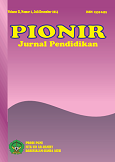ANALISIS DAYA PEMBEDA PENGECOH DAN TINGKAT KESUKARAN SOAL PENDIDIKAN AGAMA ISLAM DALAM UJIAN AHIR SEMSTER TINGKAT SEKOLAH DASAR: STUDI KASUS SDN KALIWINIG 07 RAMBIPUJI JEMBER
DOI:
https://doi.org/10.22373/pjp.v12i3.20012Keywords:
Keywords, Analysis of PAI question items, level of difficulty, differentiation power, distracting powerAbstract
Abstract
Tests are methods or procedures used in educational measurement and assessment. Tests involve giving tasks or a series of tasks to test takers, either in the form of questions that must be answered or commands that must be carried out, to produce a score that reflects the test taker's behavior or achievements. Question item analysis is an activity to evaluate each item or question item to assess its quality. Item analysis is the process of reviewing questions in a test with the aim of obtaining a set of quality questions. Therefore, analysis is needed regarding the quality of the questions, both in terms of level of difficulty, discrimination and distracting power. The research used to analyze the question items used a quantitative descriptive research design. Type of quantitative descriptive research. The population in this study were fourth grade students at SDN Kaliwining 07 Rambipuji Jember. The research sample consisted of 21 students in one class, with the class IV Islamic Religious Education subject as the research object. The instruments used in this research include end-of-semester exam question sheets, answer keys, and student answer sheets which are used as data for analysis. The data collection techniques used in this research are observation and documentation. Quantitative data analysis in this research was carried out using a computer application called Iteman, which is special software for analyzing test items. The results of this analysis show that the level of difficulty of the question items shows that each question item has a good level of difficulty. This can be seen from the question items which have a difficulty value or P value between 0.3-0.7, which is the level of difficulty stated. good if it has a vulnerability of 0.2-0.8. So that the questions analyzed based on students' answers have a good level of difficulty. Meanwhile, the different power results of the questions get several different results, from bad, average, and good. This is shown by the Rpbis results A. 0.496, B. 0.023, C. -0.166, and D. -0.166. So some of the differentiating powers contained in the question items are not yet able to distinguish between students who differentiate between the abilities of students who have mastered and who have not mastered the competencies achieved. Therefore, improvements are needed from the school or educators. The distracting power, which obtained good and very good criteria, can be seen from the results of prop A. 0.095, B. 0.382, C. 0.429, D. 0.095. which are classified as good and very good criteria, so that each question item is chosen in the same proportion by students.
References
Arifin, Z. 2014. Evaluasi Pembelajaran. Bandung: PT Remaja Rosdakarya.
Arifin, Z. 2016. Evaluasi Pembelajaran.Bandung: PT Remaja Rosdakarya.
Arikunto, S. 2012. Dasar-Dasar Evaluasi Pendidikan. Jakarta: Bumi Aksara
Arikunto, S. 2013. Prosedur Penelitian: Suatu Pendekatan Praktik. Jakarta: Rineka Cipata.
Desmita. 2012. Psikologi Perkembangan Peserta Didik (Panduan bagi Orang Tua dan Guru dalam Memahami Psikologi Anak Usia SD, SMP, dan SMA). Bandung: PT Remaja Rosdakarya.
Farida, I. 2017. Evaluasi Pembelajaran Berdasarkan Kurikulum Nasional. Bandung: PT Remaja Rosdakarya
Kunandar. 2014. Penilaian Autentik (Penilaian Hasil Belajar Peserta Didik Berdasarkan Kurikulum 2013. Jakarta: Rajawali Press.
Molstad, C. E., &Karseth, B. 2016. National Curricula in Norway and Finland: The Role of Learning Outcomes. European Educational Research Journal, 15(3), 329-344.
Mutakin, T.Z. & Teti, S. 2011. Pengaruh penggunaan media belajar dan minat belajar terhadap hasil belajar matematika. Jurnal Formatif, 1 (1): 70-81.
Popenici, S., & Millar, V.(2015). Writing Learning Outcomes.A practical guide foracademics. University of Melbourne, Australia.
Subali, B. 2012. Prinsip Asesmen & Evaluasi Pembelajaran. Yogyakarta: UNY Press. Sudijono, A. 2011. Pengantar Evaluasi Pendidikan. Jakarta: Rajawali Pers.
Sudijono, A. 2015. Pengantar Evaluasi pendidikan. Jakarta: PT. Raja Grafindo Persada Sudjana, N. 2014. Penilaian Hasil Proses Belajar Mengajar. Bandung: PT Remaja Rosdakarya
Sugiyono. 2012. Memahami Penelitian Kuantitatif Kualitatif. Alfabeta: Bandung.
Sugiyono. 2017. Metode Penelitian Kuantitatif, Kualitatif, dan R&D. Bandung: Alfabeta. Wati, E.R. 2016. Kupas Tuntas Evalusi Pembelajaran. Jakarta: Kata Pena.
Susetyo, B. 2015. Prosedur penyusunan dan analisis tes untuk penilaian hasil belajar bidang kognitif. Bandung: Refika Aditama
Susetyo, B. 2015. Prosedur penyusunan dan analisis tes untuk penilaian hasil belajar bidang kognitif. Bandung: Refika Aditama.
Widoyoko, E. P.S. 2016. Penilaian Hasil Pembelajaran di Sekolah. Yogyakarta: Pustaka Pelajar.
Widoyoko, E.P.S. 2018. Penilian Hasil Pembelajaran di Sekolah. Yogyakarta: Pustaka Pelajar.
Downloads
Published
Issue
Section
License
- Authors retain copyright and grant the journal right of first publication with the work simultaneously licensed under a Creative Commons Attribution License that allows others to share the work with an acknowledgment of the work's authorship and initial publication in this journal.
- Authors are able to enter into separate, additional contractual arrangements for the non-exclusive distribution of the journal's published version of the work (e.g., post it to an institutional repository or publish it in a book), with an acknowledgment of its initial publication in this journal.
- Authors are permitted and encouraged to post their work online (e.g., in institutional repositories or on their website) prior to and during the submission process, as it can lead to productive exchanges, as well as earlier and greater citation of published work (See The Effect of Open Access).

